


 |
May 19-26, 2017: A Week in Berlin, Germany |
 |
March 30 - April 2, 2017: A Visit to San Antonio |
 |
Return to the Index for 2017 |
On Thursday, April 27, Guy came up from San Antonio to visit us here in Dallas. We see him in San Antonio frequently, so it was nice to have him here in Dallas for a change. Guy has come just to hang out and get away from San Antonio, so we didn't plan much- except for a trip to the Dallas Arboretum (which is something Guy always likes to do when he comes to visit). All our pictures on this page will be from that visit to the Arboretum.
Getting to the Dallas Arboretum
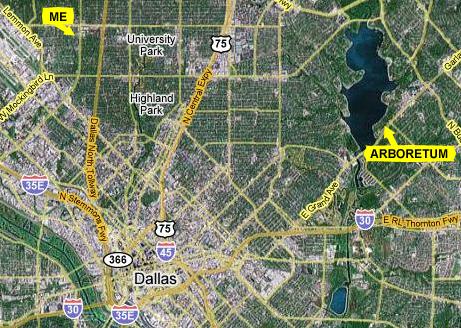 |
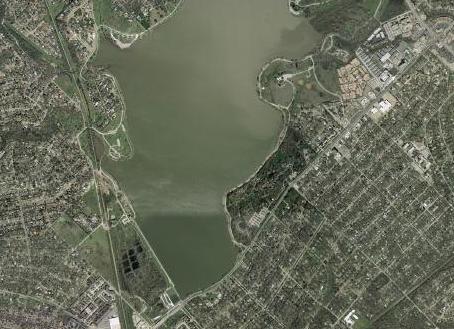 |
The bike path used to cross the top of the dam, but for one reason or another, the bike path was rerouted some years ago, and now it goes through some parkland and playing fields south of the dam, across the spillway, up Garland Road for a ways, and then back north along the lake shore.
You can also see a closer view of the Arboretum in this picture, and can begin to pick out some of the pathways through the gardens.
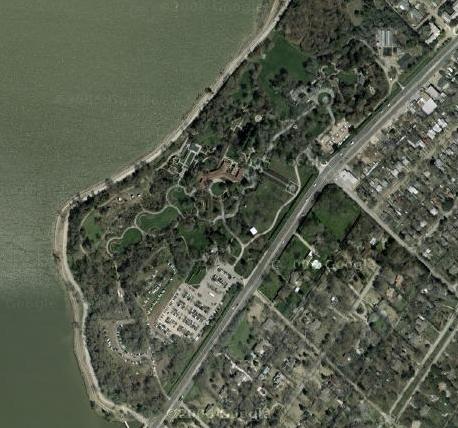 |
You can also see the maze of pathways that criss-cross the gardens.
The three of us actually took Mockingbird Lane all the way across town and across the bridge at the top of White Rock Lake to Buckner Boulevard, which we took south to Gaston Avenue. Then we came back southwest to the main Arboretum entrance. We usually make a circular transit of the entire Arboretum each time we visit, and we will do that today. We'll start out by going across the north side of the gardens and back to the Lay Family Garden. We will probably just walk with Guy to the entrance to the Rory Meyers Children's Garden but not go in. Then, we'll return to the entry along the Paseo de Flores.
|
1. Trammel Crow Entry Plaza
2. Palmer Fern Dell
3. Jonsson Color Garden
4. A Woman's Garden
5. McCasland Sunken Garden
6. Seay Magnolia Glade
7. Rudchik Red Maple Rill
8. Lay Family Garden
and the Paseo de Flores
We didn't take pictures in all the gardens, but for those where we did, there will be a little section below. Of course, we also visited the Art Fair that was going on in conjunction with ZimSculpt.
When we arrived at the Arboretum, we discovered that there was a special show going on. "ZimSculpt" was an exhibition of contemporary stone sculptures from Zimbabwe. The exhibition has already been sited at two other gardens in the United States, but this will be its first time being displayed anywhere in the southern US. We look forward to seeing the 101 sculptures as we walk through the gardens. Of course, with my penchant for recording everything, I hope to take pictures of all the sculptures. (Sadly, I discovered when I reviewed my pictures a few days later, that I had missed five of them.)
At the Trammel Crow Entry Plaza (1)
|
When you come through the members' entrance you are at the top of this plaza with the gift shop and restaurant to your left and an information station and the education building to your right. The plaza opens up in front of you. We took two pictures here in teh entry plaza- one outside the plaza and one by the fountain inside:
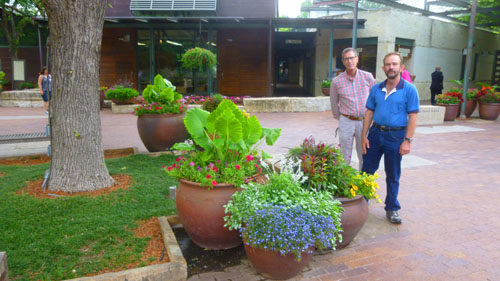 Just Inside the Entrance |
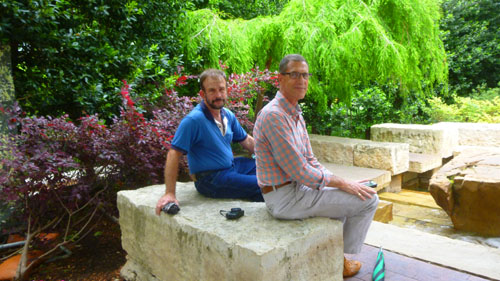 By the Entry Plaza Fountain |
You can leave the plaza via the Paseo del Flores ahead of you on the right or you can take the walkway down to the Fern Dell and the west end of the Jonsson Color Garden that is found on your left past the restaurant; there was some construction going on that blocked the walkway down into the Fern Dell (2), so we chose to walk down the Paseo del Flores until we could turn and stop and visit the Jonsson Color Garden.
The Jonsson Color Garden (3)
Recently, the Arboretum hosted a show of bronze sculptures, and you've probably seen pictures of them on an earlier page. The Arboretum acquired one of the sculptures for permanent display- a statue of William Shakespeare that is always a nice backdrop for a picture or two- and it is located at the southeast border of the color garden:
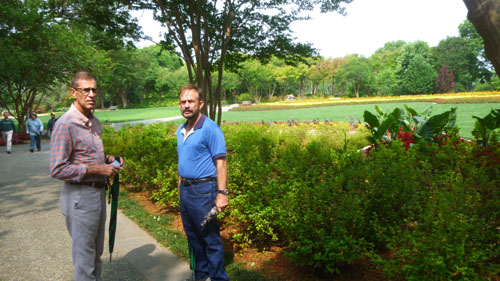 At the Jonsson Color Garden |
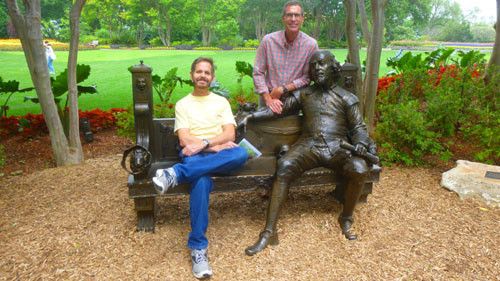 Will and Guy and I |
Down near the Fern Dell, there is one interior garden called the Waterwise display, donated by Region IV of the Texas Nursery and Landscape Association. It provides a location for home gardeners to learn how to install and manage a low-water landscape. Usually, we go from the Color Garden directly into A Woman's Garden (4), but today we went back to the Paseo del Flores to visit the "art fair" that was going on in conjunction with the ZimSculpt exhibition.
At the Art Fair
|
(Mouseover Image Above for Video Controls) |
(Mouseover Image Above for Video Controls) |
This small art fair reminded us very much of those that we visit frequently when we are in Florida, and we took a number of pictures of the fair both from the Paseo and while walking amongst the stalls. Here are some of those pictures:
|
It was a pleasure walking through the fair; we each found something interesting to purchase!
The McCasland Sunken Garden (5)
|
At the top of the garden, there are stairs leading down to a water feature and a bronze. The Chico y Chica de la Playa sculpture and accompanying fountain provide a tranquil setting for the many weddings that take place in this secluded garden.
Here are three other pictures that we took here in the Sunken Garden:
The Seay Magnolia Glade (6)
|
(Mouseover Image Above for Video Controls) |
I made a short movie while we were standing here, and you can use the player at left to watch it.
Designed by Landscape Architect Warren Hill Johnson, the glade takes on different colors and textures throughout the year, but with the significant color within to be varied plantings of green and white. Framed by the 45-foot magnolias of the Dallas Arboretum’s Magnolia Allee, the glade is gently enclosed by 35 new ‘Teddy Bear’ southern magnolias. Butterfly Japanese Maples, large white flowering camellias, loquats and many others add to the palette of interesting horticulture within this peaceful garden. At the east end of the allee there is one more circular fountain and an archway that leads through to the Nancy Rudchik Red Maple Rill.
The Nancy Rudchik Red Maple Rill (7)
This premier addition to the Arboretum was designed by Rowland Jackson. Key design elements of the Nancy Rutchik Red Maple Rill include a new entry off the Paseo de Flores and a large gathering plaza that overlooks a re-circulating creek and numerous waterfalls. Opened in fall 2011, this charming area also includes a series of paved walkways and a stone bridge connecting the Martin Rutchik Concert Stage and the Performance Lawn to the Magnolia Allee. An especially large weeping Japanese maple, nearly 100 years old, anchors the center of the garden.
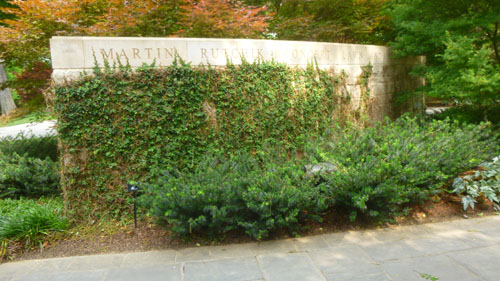 Entry to the Concert Stage |
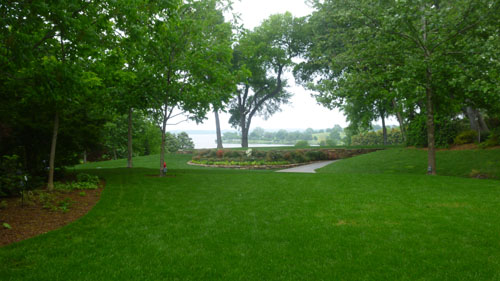 The Performance Lawn |
We left the Red Maple Rill to go to the east end of the Arboretum to walk through the Lay Garden.
The Lay Family Garden (8)
The garden sports a new, walk-behind waterfall, which feeds the large lily and koi ponds here in the Lay Garden, and it is interesting in that there are actual fossils embedded in the stone walls of the waterfall. The recent renovation of the Lay Garden, at which time the fossil waterfall was added, was a major one. The pathways leading to the garden and the actual entrance had to be reworked. Three new entrances now feed into the garden from the Paseo extension linking the Camp House Circle with the Rory Meyers Children’s Adventure Garden. The Arboretum preserved the former entry courtyard, but it has now become a pocket garden and more of a destination than a passageway. Maintained and reworked were the large lagoon for aquatic plants, a stream with three weirs and the Koi pond.
|
|
We left the Lay Garden via the new entrance off the Paseo to walk back along the main garden walkway towards the entrance.
Along the Paseo del Flores
|
|
In some of these pictures, you'll also see the Art Fair in the background.
To allow you to flip through these pictures quickly and easily, I've put them in a slideshow, and that show is at right.
To move from image to image, just click on the little arrows in the lower corners of each one. There are 23 pictures in this particular slideshow, and you can refer to the index numbers in the upper left of each slide to see where you are in the show. I hope you find the pictures worthwhile; the Arboretum is always an amazing place.
We got back to the Trammel Crow Entrance Plaza in late afternoon, after having spent three hours or so here in the Gardens. They are always an interesting and beautiful place to visit.
The ZimSculpt Exhibition
The ZimSculpt organization is passionate about promoting the work of some of the finest Zimbabwean sculptors. Not only were some 101 completed pieces on display throughout the gardens, but two Zimbabwean artists, Passmore Mupindiko and Aron Kapembeza, actually worked on new commissions in a large kiosk near the Art Fair, demonstrating their artistry by carving statues using chisels, hammers, files and sandpaper, while guests watch and learn about this art.
|
|
As I mentioned earlier, I got into my "documenting mode" during our visit to the Arboretum today, and tried to photograph each of the 101 sculptures. Considering that I didn't have a map of where each one was located, I think I did pretty well to find all but five of them. I have created a slideshow of these photographs, since there are so many of them.
On each slide, you'll see the sculpture itself, along with its title, its creator, and the medium (usually some kind of stone). As with all the slide shows in this album, you can move through the pictures using the little arrows in the lower corners of each slide. And you can refer to the index numbers in the upper left of each slide to track your progress through the show.
According to Mark Wolf, Dallas Arboretum board chairman, “We are always looking for unique displays that will do well in a garden setting, and the magnificent contemporary stone statues will fit perfectly within our various gardens. We’re also thrilled that it will be the first time this exhibition will be featured in the southern U.S., thus attracting visitors from the area.”
Wolf added, “These unique art pieces resonate with roots from their African homeland. These statues are strong and delicate, stark and complex, contemporary and exquisitely handmade. Everything is done by hand at a high level with tools to carve these stones, and when guests see these artists chisel stone in person, they will see how much work goes into creating these works of art.” I am pretty certain that you, the visitor to this photo album, have not seen this exhibition, and so I hope that you find the pictures I took to be an acceptable substitute for actually seeing it in person.
Guy stayed with us for four days, but other than the pictures on this album page, we took no others of note during his visit.
You can use the links below to continue to another photo album page.
 |
May 19-26, 2017: A Week in Berlin, Germany |
 |
March 30 - April 2, 2017: A Visit to San Antonio |
 |
Return to the Index for 2017 |